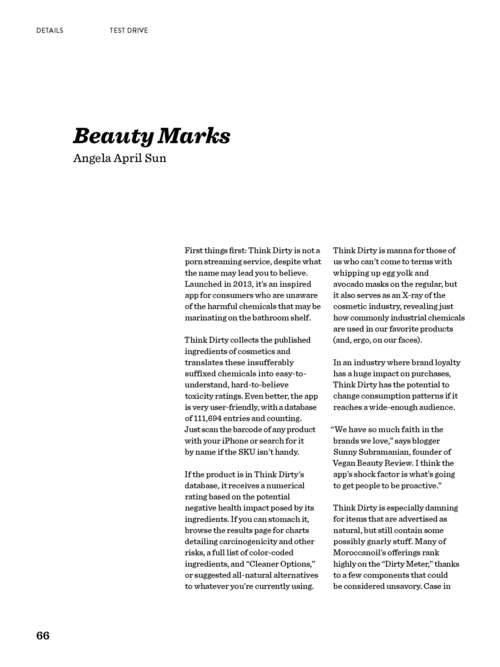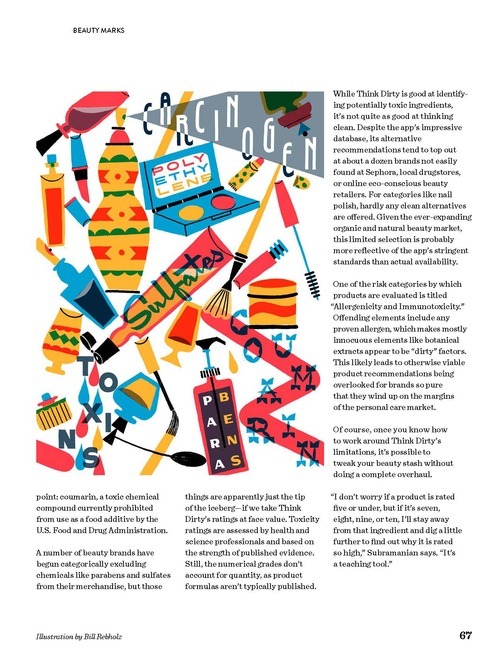
We are so excited being mentioned in the debut of this up and coming modern magazine for smart and tasteful women from NYC – Golly!
Repost from original piece from Golly Magazine.
Beauty Marks by Angela April Sun
First things first: Think Dirty is not a porn streaming service, despite what the name may lead you to believe. Launched in 2013, it’s an inspired app for consumers who are unaware of the harmful chemicals that may be marinating on the bathroom shelf.
Think Dirty collects the published ingredients of cosmetics and translates these insufferably suffixed chemicals into easy-tounderstand, hard-to-believe toxicity ratings. Even better, the app is very user-friendly, with a database of 111,694 entries and counting. Just scan the barcode of any product with your iPhone or search for it by name if the SKU isn’t handy.
If the product is in Think Dirty’s database, it receives a numerical rating based on the potential negative health impact posed by its ingredients. If you can stomach it, browse the results page for charts detailing carcinogenicity and other risks, a full list of color-coded ingredients, and “Cleaner Options,” or suggested all-natural alternatives to whatever you’re currently using.
Think Dirty is manna for those of us who can’t come to terms with whipping up egg yolk and avocado masks on the regular, but it also serves as an X-ray of the cosmetic industry, revealing just how commonly industrial chemicals are used in our favorite products (and, ergo, on our faces).
In an industry where brand loyalty has a huge impact on purchases, Think Dirty has the potential to change consumption patterns if it reaches a wide-enough audience.
“We have so much faith in the brands we love,” says blogger Sunny Subramanian, founder of Vegan Beauty Review. I think the app’s shock factor is what’s going to get people to be proactive.”
Think Dirty is especially damning for items that are advertised as natural, but still contain some possibly gnarly stuff. Many of Moroccanoil’s offerings rank highly on the “Dirty Meter,” thanks to a few components that could be considered unsavory. Case in point: coumarin, a toxic chemical compound currently prohibited from use as a food additive by the U.S. Food and Drug Administration. A number of beauty brands have begun categorically excluding chemicals like parabens and sulfates from their merchandise, but those things are apparently just the tip of the iceberg—if we take Think Dirty’s ratings at face value. Toxicity ratings are assessed by health and science professionals and based on the strength of published evidence. Still, the numerical grades don’t account for quantity, as product formulas aren’t typically published.
While Think Dirty is good at identifying potentially toxic ingredients, it’s not quite as good at thinking clean. Despite the app’s impressive database, its alternative recommendations tend to top out at about a dozen brands not easily found at Sephora, local drugstores, or online eco-conscious beauty retailers. For categories like nail polish, hardly any clean alternatives are offered. Given the ever-expanding organic and natural beauty market, this limited selection is probably more reflective of the app’s stringent standards than actual availability.
One of the risk categories by which products are evaluated is titled “Allergenicity and Immunotoxicity.” Offending elements include any proven allergen, which makes mostly innocuous elements like botanical extracts appear to be “dirty” factors. This likely leads to otherwise viable product recommendations being overlooked for brands so pure that they wind up on the margins of the personal care market. Of course, once you know how to work around Think Dirty’s limitations, it’s possible to tweak your beauty stash without doing a complete overhaul. “I don’t worry if a product is rated five or under, but if it’s seven, eight, nine, or ten, I’ll stay away from that ingredient and dig a little further to find out why it is rated so high,” Subramanian says. “It’s a teaching tool.”
Illustration by Bill Rebholz 67

